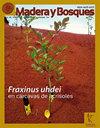Exposure of Pinus elliottii wood treated with titanium dioxide to the fungus Postia placenta and photodegradation
IF 0.4
4区 农林科学
Q4 FORESTRY
引用次数: 0
Abstract
It was impregnated commercial titanium dioxide into Pinus elliottii wood, aiming to increase its durability against the attack of brown rot fungus Postia placenta and photodegradation caused by ultraviolet radiation. The samples were put under 8 bar pressure for 3 hours at different concentrations of TiO2 (0.5%, 0.25%, 0.124% and 0%-control). To evaluate the effect of the fungus on the wood, the test was carried out according to ASTM D2017-05 and UNE-EN 113:1996 with modifications. The photodegradation was performed by exposing a tangential section to ultraviolet radiation for 400 hours, and the colorimetric parameters were periodically evaluated. Statistically, the treatments with TiO2 did not differ among themselves, but were much lower than the control, showing the effectiveness of this product in protecting the wood against the attacks of degraders. As for the photodegradation, the treated wood remained practically unchanged, differently from the control that had a darkening accelerated mainly in the first 50 hours. With this information, it can be stated that TiO2 treated wood is able to hinder the fungus access to the cell wall, to inhibit its growth and to create a barrier that protects the polymers from photodegradation, increasing its durability and emerging as a potential alternative for wood treatment.用二氧化钛处理过的油松木材暴露于光降解真菌Postia胎盘
将商用二氧化钛浸渍在湿地松木材中,以提高其抗褐腐菌的侵袭和抗紫外线光降解的耐久性。在不同浓度的TiO2(0.5%、0.25%、0.124%和0%对照)下,将样品置于8 bar压力下3小时。为了评估真菌对木材的影响,根据ASTM D2017-05和UNE-EN 113:1996进行了修改。通过将切向切片暴露在紫外线下400小时进行光降解,并定期评估比色参数。从统计学上看,使用TiO2的处理之间没有差异,但比对照低得多,表明该产品在保护木材免受降解物攻击方面的有效性。至于光降解,处理过的木材几乎没有变化,与对照不同,暗化主要在前50小时加速。有了这些信息,可以说明TiO2处理的木材能够阻止真菌进入细胞壁,抑制其生长,并创建一个屏障,保护聚合物免受光降解,增加其耐久性,并成为木材处理的潜在替代方案。
本文章由计算机程序翻译,如有差异,请以英文原文为准。
求助全文
约1分钟内获得全文
求助全文
来源期刊

Madera Y Bosques
FORESTRY-
CiteScore
0.90
自引率
0.00%
发文量
16
审稿时长
>12 weeks
期刊介绍:
Madera y Bosques (Wood and Forests) is a scientific periodical journal which has the objective of serving as media for scientific and technological research related to forest products, forest management and conservation as well as forest ecology topics and related subjects. It publishes original scientific papers, topical articles, scientific notes or bibliographic reviews. It is a quarterly publication that appears in Spring, Summer and Fall. Ocassionally, special Winter Issues are published. Manuscripts are accepted in Spanish, English and sporadically in other languages. It has no Page Processing Charges and it is published by the Environment and Sustainability Department of the Instituto de Ecología, A.C. (Xalapa, Ver., México).
 求助内容:
求助内容: 应助结果提醒方式:
应助结果提醒方式:


